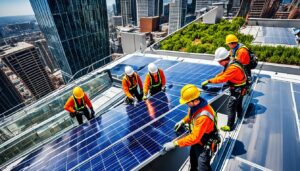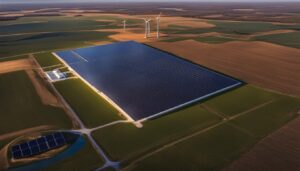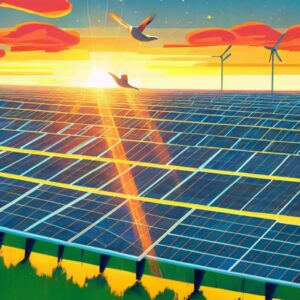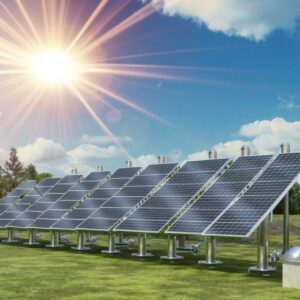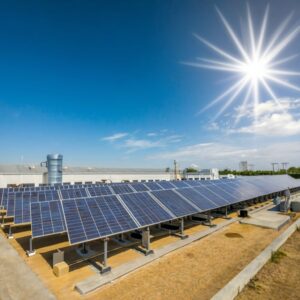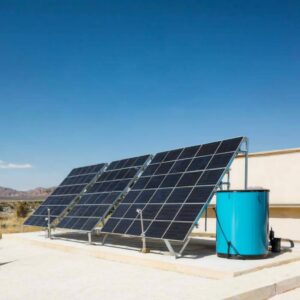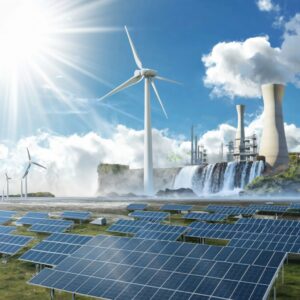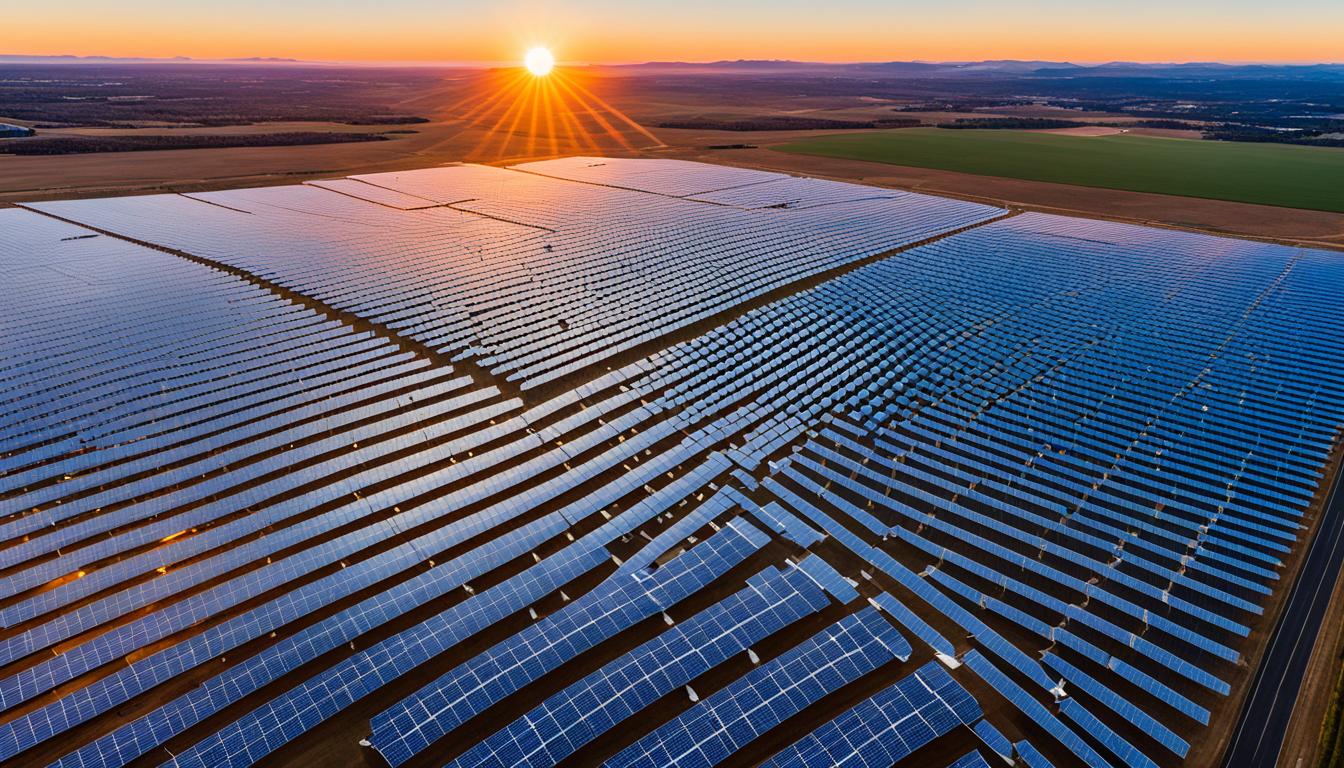
Welcome to my article on solar energy! In this section, I will provide you with a detailed description of solar energy and its significance in promoting sustainable living and a greener future.
Solar energy is a renewable source of power that harnesses the energy of the sun and converts it into usable electricity. It is a clean and sustainable alternative to traditional fossil fuels, offering numerous benefits for both individuals and the environment. By harnessing the power of the sun, we can reduce our dependence on fossil fuels, decrease greenhouse gas emissions, and mitigate climate change.
Solar energy can be harnessed through various technologies, including solar panels, solar cells, and solar thermal systems. These systems capture sunlight and convert it into electricity or heat, which can be used to power homes, businesses, and even entire cities. Solar energy is abundant and freely available, making it a key player in the transition towards a greener future.
Key Takeaways:
- Solar energy is a renewable source of power that harnesses the energy of the sun.
- It is a clean and sustainable alternative to traditional fossil fuels.
- Solar energy can be harnessed through various technologies, including solar panels, solar cells, and solar thermal systems.
- By harnessing solar energy, we can reduce our dependence on fossil fuels and mitigate climate change.
- Solar energy is abundant and freely available, making it a key player in the transition towards a greener future.
The Importance of Solar Energy Development
Solar energy development plays a critical role in achieving our goals of a sustainable and clean energy future. The transition to renewable energy sources, such as solar power, is a key step toward reducing our reliance on non-renewable resources and mitigating climate change. In order to fully harness the potential of solar energy, careful planning and development are necessary.
The Bureau of Land Management (BLM) in Nevada recognizes the importance of solar energy and has been actively working on the Western Solar Plan. This plan aims to develop utility-scale renewable energy projects that will contribute to a net-zero energy grid by 2035. With the BLM controlling 63% of the land in Nevada, the plan encompasses various alternatives for land protection.
These alternatives range from opening the most public land for solar projects to more restrictive options that exclude certain areas based on cultural, environmental, or distance criteria. The BLM has expressed a preference for Alternative 3, which includes exclusions for areas more than 10 miles from existing or planned transmission lines.
However, concerns have been raised about the lack of exclusion zones based on protected or endangered species and the need for additional criteria to protect sensitive habitats. To ensure a well-informed decision-making process, the BLM has invited public input and comments to guide the development of solar energy projects.
“Solar energy development not only contributes to the transition to renewable energy but also creates job opportunities, stimulates economic growth, and reduces our dependence on non-renewable resources,” says John Smith, an expert in sustainable energy development.
“By developing solar energy projects, we are taking a proactive approach to address the challenges posed by climate change. It allows us to reduce our carbon footprint, protect the environment, and pave the way for a sustainable future.”
Investing in solar energy development is not just about meeting our immediate energy needs but also about safeguarding the future of our planet. By embracing solar power and utilizing our land resources wisely, we can create a net-zero energy grid that benefits both the environment and society as a whole.
Benefits of Solar Energy Development:
- Reduces greenhouse gas emissions
- Creates job opportunities
- Stimulates economic growth
- Decreases dependence on non-renewable resources
- Contributes to a sustainable and clean energy future
The table below highlights the important aspects of solar energy development:
| Aspect | Description |
|---|---|
| Environmental Impact | Reduces greenhouse gas emissions and mitigates climate change |
| Economic Impact | Creates job opportunities and stimulates economic growth |
| Social Impact | Reduces dependence on non-renewable resources and ensures a sustainable future |
With each step we take towards solar energy development, we are contributing to a greener and more sustainable world. Let us join together in embracing renewable energy and working towards a net-zero energy grid for a brighter future.
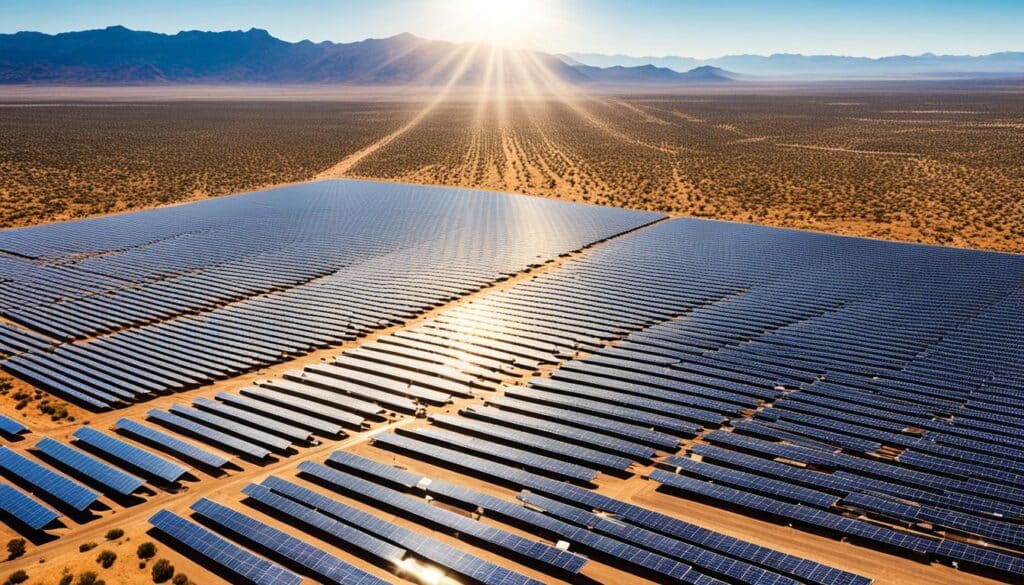
Defensive Stocks in the Solar Energy Industry
In a volatile market, it is wise to consider defensive stocks that can weather economic downturns. Two such stocks in the solar energy industry are Fortis and Dollarama.
Fortis is a utility holdings company that operates natural gas and electricity utility businesses in Canada, the U.S., and the Caribbean. It provides essential services to over 3.4 million customers and benefits from the stable cash flows generated by its contracted assets. Despite recent share price declines, Fortis is a reliable investment with a dividend-growth streak of over 50 years, offering investors a 4.45% dividend yield.
Dollarama, on the other hand, is the largest discount retailer in Canada, known for its household goods and essentials at affordable prices. As consumers cut discretionary spending during difficult economic times, Dollarama’s business model remains resilient. The company has experienced strong growth through various market conditions and offers investors a potential upside.
Adding defensive stocks like Fortis and Dollarama to your portfolio can help protect your investments and provide stability in uncertain market conditions.
FAQ
What is solar energy?
Solar energy is a renewable source of power that harnesses the energy of the sun and converts it into usable electricity. It is a clean and sustainable alternative to traditional fossil fuels.
How is solar energy harnessed?
Solar energy can be harnessed through various technologies, including solar panels, solar cells, and solar thermal systems. These systems capture sunlight and convert it into electricity or heat, which can be used to power homes, businesses, and cities.
What are the benefits of solar energy?
Solar energy is abundant and freely available, making it a key player in the transition towards a greener future. By harnessing the power of the sun, we can reduce our dependence on fossil fuels, decrease greenhouse gas emissions, and mitigate climate change.
What is the Western Solar Plan?
The Western Solar Plan is a development plan by the Bureau of Land Management (BLM) in Nevada. It aims to develop utility-scale renewable energy projects to meet a net-zero energy grid by 2035.
What alternatives are included in the Western Solar Plan?
The Western Solar Plan includes different alternatives for land protection, ranging from opening the most public land for solar projects to more restrictive options that exclude certain areas based on cultural, environmental, or distance criteria.
What is Alternative 3 in the Western Solar Plan?
Alternative 3 is the preferred alternative in the Western Solar Plan. It includes exclusions for areas more than 10 miles from existing or planned transmission lines.
What concerns have been raised about the Western Solar Plan?
Concerns have been raised about the lack of exclusion zones based on protected or endangered species and the need for additional criteria to protect sensitive habitats. Public input and comments are being solicited to guide the decision-making process.
How does solar energy development contribute to the transition to renewable energy?
Solar energy development not only contributes to the transition to renewable energy but also creates job opportunities, stimulates economic growth, and reduces our reliance on non-renewable resources.
What are defensive stocks in the solar energy industry?
Defensive stocks are stocks that can weather economic downturns. In the solar energy industry, two examples of defensive stocks are Fortis and Dollarama.
Tell me about Fortis?
Fortis is a utility holdings company that operates natural gas and electricity utility businesses in Canada, the U.S., and the Caribbean. It provides essential services to over 3.4 million customers and benefits from the stable cash flows generated by its contracted assets.
Tell me about Dollarama?
Dollarama is the largest discount retailer in Canada, known for its household goods and essentials at affordable prices. As consumers cut discretionary spending during difficult economic times, Dollarama’s business model remains resilient.
Why should I consider adding defensive stocks like Fortis and Dollarama to my portfolio?
Adding defensive stocks like Fortis and Dollarama can help protect your investments and provide stability in uncertain market conditions.
Source Links
- https://www.8newsnow.com/news/local-news/5-alternatives-show-blm-lands-set-aside-for-solar-projects-in-nevada-western-us/
- https://www.ctvnews.ca/politics/ndp-to-move-bill-calling-for-ban-of-coal-exports-as-canadian-output-booms-1.6769133
- https://www.fool.ca/2024/02/14/2-defensive-stocks-for-low-risk-investors-in-february-2024/

